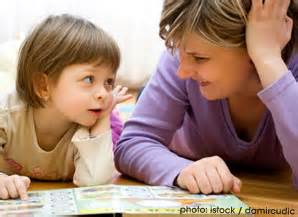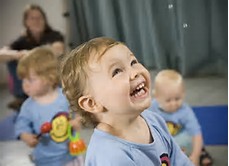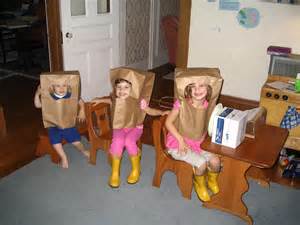Five Early Literacy Practices
ECRR 2 emphasizes the five practices of talking, singing, reading, writing and playing. These practices help children learn how to read and are fun for children of all ages. They have the added advantage of being easy to do almost anywhere, and the simple language makes them more accessible for parents and caregivers. The following overview provides food for thought about how we are incorporating these practices in a meaningful way into our storytimes and programs for young children.
Talking
 Conversations with adults are one of the key ways children develop language. Talking with children can be used to facilitate all of the six areas of early literacy development: vocabulary, narrative skills, print awareness, phonological awareness, letter knowledge and print motivation. It’s helpful to think of all the opportunities you provide for talking with children in your storytimes and programs.
Conversations with adults are one of the key ways children develop language. Talking with children can be used to facilitate all of the six areas of early literacy development: vocabulary, narrative skills, print awareness, phonological awareness, letter knowledge and print motivation. It’s helpful to think of all the opportunities you provide for talking with children in your storytimes and programs.
Key Points
- When you talk with young children, it is important to use new words to help children develop a large vocabulary. Knowing the meanings of many words will help them understand, or comprehend, what they will later read.
- You can use talking to develop language by expanding what young children say in a natural way. If a child answers you with one word, extend his language with your own. For example, if you ask, “What do you think the puppy will do now?” and the child answers, “Run away,” you could say, “Yes, the puppy is going to run away because he’s afraid.”
- When sharing a book, making connections will help children develop narrative skills and vocabulary knowledge. Help children talk about and connect characters and events in a story to their own experiences or connect one book to another book, perhaps fiction to nonfiction.
Singing
 Singing has long been a part of storytime best practices. Most programs include at least one or two songs, if not more. Singing is an effective and natural way to develop language and support the early literacy skills of letter knowledge, phonological awareness and vocabulary.
Singing has long been a part of storytime best practices. Most programs include at least one or two songs, if not more. Singing is an effective and natural way to develop language and support the early literacy skills of letter knowledge, phonological awareness and vocabulary.
Key Points
- Singing slows down language so that children can hear the different sounds in words. This is a key skill in learning how to decode, or read, words.
- Most songs have a different note for each syllable. This is a natural support in helping children begin to focus on the individual sounds in words. Clapping along to rhythms helps children tune their ears to the syllables in words.
- Singing helps children develop listening skills, as they listen to follow along with the words and rhythms of the song.
Reading
 Reading and sharing books is the cornerstone of storytime programs. Reading with young children is the single best way to help them get ready to read. Book sharing provides rich opportunities to develop all six early literacy areas, especially vocabulary and narrative skills. Reading aloud builds background knowledge and comprehension, and fosters print motivation.
Reading and sharing books is the cornerstone of storytime programs. Reading with young children is the single best way to help them get ready to read. Book sharing provides rich opportunities to develop all six early literacy areas, especially vocabulary and narrative skills. Reading aloud builds background knowledge and comprehension, and fosters print motivation.
Key Points
- It’s important to talk about what you read with children as you share the book. Inviting children to make predictions about what might happen next and/or draw connections to the characters and events helps children engage with the book.
- Children who enjoy being read to are more likely to want to learn to read. A child who shows early interest in reading is predicted to have better reading achievement.
- Shared reading helps children learn less common words and helps their vocabularies to grow. The language in books is different from everyday speech, and understanding that language is important for success in school.
Writing
 Writing development and reading development support one another; they go together. As children develop print awareness, they become aware that the print is what you are reading. They begin to see print everywhere in their world and to understand that it represents meaning and the spoken word. Their first scribbling and drawing helps to strengthen that understanding, along with their fine motor skills. Storytime programs have not traditionally included opportunities to write, but it is not difficult to add this experience in simple ways.
Writing development and reading development support one another; they go together. As children develop print awareness, they become aware that the print is what you are reading. They begin to see print everywhere in their world and to understand that it represents meaning and the spoken word. Their first scribbling and drawing helps to strengthen that understanding, along with their fine motor skills. Storytime programs have not traditionally included opportunities to write, but it is not difficult to add this experience in simple ways.
Key Points
- The time to give children the opportunity to draw and write is when they are old enough to hold a thick crayon or marker.
- Talking with children about what they write and draw helps them develop the understanding that print conveys meaning.
- As children scribble and draw, they are developing the fine motor control needed to write letters and words. Children need lots of practice to develop this skill.
Playing
 Children learn about the world of language through play. Play provides rich opportunities for children to develop vocabulary along with imagination. Storytimes have traditionally included opportunities for pretend play as songs and stories are shared.
Children learn about the world of language through play. Play provides rich opportunities for children to develop vocabulary along with imagination. Storytimes have traditionally included opportunities for pretend play as songs and stories are shared.
Key Points
- Pretend play enables children to think symbolically and develop problem-solving skills along with language skills.
- Play helps give children a sense of accomplishment. This in turn fosters self-confidence as they try new experiences.
- Dramatic play helps children develop narrative skills as they make up stories or act out a familiar tale.
